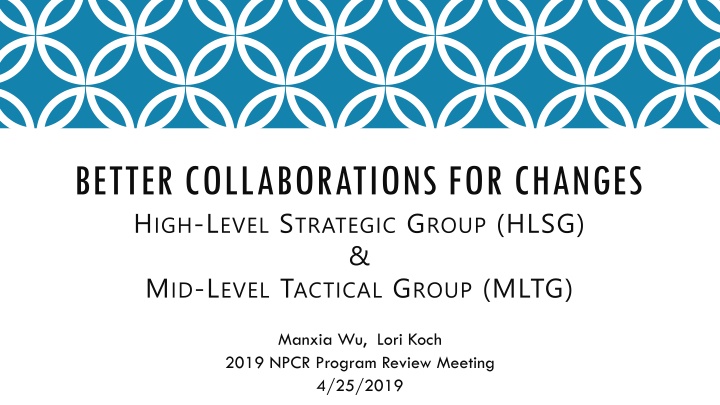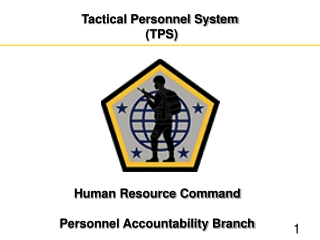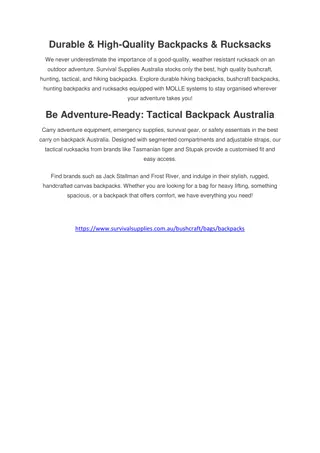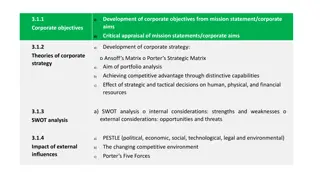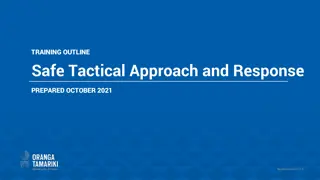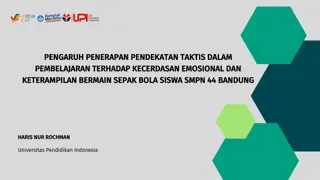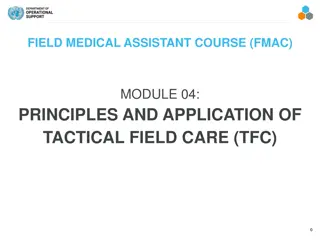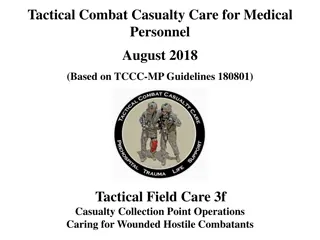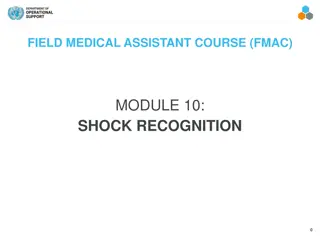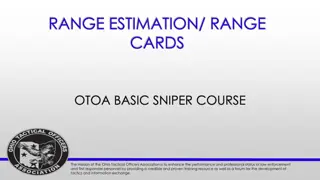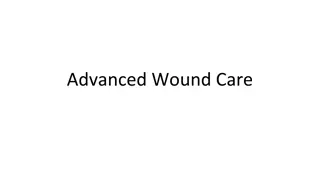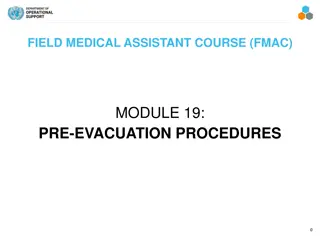Enhancing Collaboration for Strategic & Tactical Groups
This content revolves around the collaboration strategies between the High-Level Strategic Group (HLSG) and the Mid-Level Tactical Group (MLTG) in the cancer surveillance community. The HLSG aims at coordinating major changes across cancer surveillance organizations, while the MLTG focuses on forecasting and implementing new standards. The primary purposes and activities of these groups are outlined to ensure effective coordination and communication in advancing cancer surveillance practices.
Download Presentation

Please find below an Image/Link to download the presentation.
The content on the website is provided AS IS for your information and personal use only. It may not be sold, licensed, or shared on other websites without obtaining consent from the author.If you encounter any issues during the download, it is possible that the publisher has removed the file from their server.
You are allowed to download the files provided on this website for personal or commercial use, subject to the condition that they are used lawfully. All files are the property of their respective owners.
The content on the website is provided AS IS for your information and personal use only. It may not be sold, licensed, or shared on other websites without obtaining consent from the author.
E N D
Presentation Transcript
BETTER COLLABORATIONS FOR CHANGES HIGH-LEVEL STRATEGIC GROUP (HLSG) & MID-LEVEL TACTICAL GROUP (MLTG) Manxia Wu, Lori Koch 2019 NPCR Program Review Meeting 4/25/2019
CANCER SURVEILLANCE COMMUNITY Always Striving to Do Better
WHAT WE ARE EXPERIENCING - SS2018 SSDIs Grade MPH rules Radiation changes Hematopoietic updates ICDO3 AJCC 8thedition EOD
HIGH-LEVEL STRATEGIC GROUP (HLSG) & MID-LEVEL TACTICAL GROUP (MLTG) NAACCR convened two groups, each with 12 voting members - HLSG: meet quarterly - MLTG: meet monthly The two groups consist of representatives from funding agencies and standard setting organizations - ACoS/AJCC, ACoS/NCDB, CCCR (Canada), CDC NPCR, NAACCR, NCI SEER, and NCRA
PRIMARY PURPOSESOF HLSG Ensure high-level coordination and communication among all cancer surveillance organizations regarding the development and implementation of major changes in standards and procedures. Facilitate communications and collaboration between the cancer registry/surveillance leadership community and organizational leadership of represented clinical organizations.
PRIMARY PURPOSESOF MLTG Forecast changes to cancer surveillance collections standards, evaluate needs to adapt to changes of oncology practice, and prepare an annual report with recommendations of new standards (or changes to current standards) to be adopted (or rejected) by the HLSG. Plan for the development of technical standards/specifications for changes approved by the HLSG. Coordinate the implementation of changes approved by the HLSG that also completed the development phase. Identify gaps in resources needed to accomplish development and implementation initiatives and (if appropriate) make recommendations to HLSG for allocation of additional resources.
ACTIVITY 1 PROCEDURES AND TIMELINE FOR NEW DATA ITEMS
Standard Setter: Notified to conduct and deliver field test results NEW DATA STANDARDS INITIATION MLTG NAACCR support staff: transmits documentation to UDS identifies and transmits documentation to other NAACCR technical groups for review as required by NAACCR policy Standard Setter: identifies need for new data standard defines concept drafts definitions and codes performs preliminary feasibility assessment (PFA) per NAACCR & MLTG guidelines transmits completed PFA to MLTG transmits supporting documentation MLTG: reviews and issues preliminary recommendation recommendation issued in 9 weeks or less Favorable preliminary MLTG recommendation Unfavorable preliminary MLTG recommendation (written justification required) UDS & other NAACCR technical groups: Receives documentation with favorable MLTG preliminary recommendation Standard Setter: revises and resubmits PFA Standard Setter: reviews MLTG written recommendation Standard Setter: aborts process
NAACCR TECHNICAL REVIEW & FIELD TESTING Standard Setter: performs field testing per NAACCR and MLTG field testing guidelines provides field testing results and summary findings to MLTG MLTG partners to promote the setup and support he maintenance of a field test network works with UDS and other NAACCR technical groups to answer technical questions, including any available field test results MLTG: reviews final format of definitions, codes and rules reviews field testing results and summary findings returns item to Standard Setter if necessary prepares recommendation for High-level Strategic Group (HLSG) and implementation timeline High-level Strategic Group (HLSG): reviews, accepts, modifies, or rejects implementation timeline confirms completion of development and issues implementation decision to MLTG NAACCR Program Manager of Standards: collects approved definitions, codes and coding rules from UDS & other NAACCR technical groups reviews, certifies and informs MLTG that new data items can be included in Data Standards and Data Dictionary UDS & other NAACCR technical groups: reviews definitions, codes and coding rule interacts with the standard setter to amend codes and definitions as necessary MLTG
ALTERNATE PROCESS FOR NEW DATA STANDARD OR CHANGE PROPOSED BY STANDARD SETTER WITH REQUEST FOR EXEMPTION FROM REQUIREMENT FOR FULL PFA AND/OR FIELD TEST* MLTG: Reviews UDS- approved changes Considers target date for implementation Provides recommendations to HLSG MLTG: reviews and issues preliminary recommendation re: both proposed changes and PFA/field test exemption Standard Setter: identifies need for new data standard or change in existing data standard Proposes to MLTG with rationale for proceeding without full PFA and/or field test UDS: MLTG approves and forwards proposal to UDS without PFA and/or field test) reviews proposed changes & recommends approval or disapproval if approved, works with standard setter to finalize codes and coding instructions if disapproved, provide written justification to standard setter & MLTG Unfavorable preliminary MLTG recommendation (written justification required) HLSG: Reviews MLTG recommendations Approves or disapproves Standard Setter: revises and resubmits proposal (may need to conduct full PFA &/or commit to field test) Standard Setter: reviews MLTG written recommendation * It is anticipated that complete exemption from PFA and/or field testing will be uncommon but it is nonetheless useful to have the process defined
IMPLEMENTATION PROCESS NAACCR Implementation WG : NAACCR Implementation Guide NAACCR Edits WG : Program specific EDITS Metafile Software modification at registry and facility levels : Update cancer management systems Updates API and libraries HLSG MLTG Education and training : NCRA SEER Training Website, SEER*Educate NPCR NAACCR Manager of Education Programs Other stakeholders : As necessary
Draft process and timeline for development and implementation of new SSDIs for 2021 (target completion by August 1, 2020) February 2019 March 2019 April 2019 May 2019 June 2019 August 2019 September 2019 October 2019 November 2019 December 2019 January 2020 February 2020 March 2020 April 2020 May 2020 June 2020 July 2020 Draft data items and codes reviewed by SSDI Complete plans for feasibility data collection Feasibility data collection & review SSDI Approval MLTG Approval UDS Comments Final MLTG Review NAACCR Processes for 2021 Field test data collection and review. Final UDS review SLST approval Develop plans for field test Implementation Finalize codes and coding instructions. Preliminary review of codes and feasibility plan by MLTG MLTG and NAACCR evaluate new Change Management; propose changes as needed Periodic informational updates to MLTG on field test plan and progress
SUMMARY 1: PROCEDURES AND TIMELINE FOR NEW DATA ITEMS Feasibility study required for each new data item before implementation Estimated minimal 9-12 months before implementation. Time includes: - Plan and technical development - Feasibility study At least 6 months of implementation. Activities includes: - Guidelines development - Review and approval - Edits - Education and Training - Central Registry level software modification, test and update - Vendor (facilities) level software test and update
ACTIVITY 2 REGISTRY READINESS FOR 2018 DATA CHANGES
Example 1 of 2018 Readiness Survey Result: - How many 2018 cases have you processed so far (by 3/1/2019)? (as a percentage of expected cases) 2018 cases processed Number of registries 0% 24 0.05-5% 13 5-12% 5 59% 1 70% 1
Example 2 of 2018 Readiness Survey Result: - Has your central registry finalized the v18 Edits Metafile for distribution to reporting facility software vendors (by 3/1/2019)? Don t know/ didn t answer Yes No SEER*DMS 8 1 1 Registry Plus 7 8 0 Rocky Mountain 2 6 1 In-house 3 4 0 Other 0 3 0 TOTAL 15 22 2
ADVERSE IMPACTS OF THE DELAY IDENTIFIED BY NUMEROUS REGISTRIES Incomplete data leading to artificially low rates Data quality problems generally Delay in mandated reports Delay in scheduled linkages, or incomplete linkages Delay in existing and proposed research projects Delay in workers compensation claims Expectation of negative press/bad public relations Need to generate warning messages to attach to all files/reports/analyses
SUMMARY 2: 2018 REGISTRY READINESS Overall substantial delays in 2018 data collection Identified the need to make distinction between NAACCR edits metafiles and state-specific edit sets - Plan for time necessary to develop state-specific edit sets Ensure sufficient development time for software updates and testing at multiple levels (API primary developers, CCRs, and facility vendors) Training focused on 2018 changes still an issue, in particular for solid tumor rules
ACTIVITY 3 REQUESTED CHANGES FOR 2020 IMPLEMENTATION
CHANGES PROPOSED FOR 2020 1) Addition of new yc data items - Clinical post-neoadjuvant data items by AJCC 2) Full implementation of XML transmission format - Replace data exchange fixed column format for Volume II, V20. 3) SSDI changes - Updates/clarifications on existing 14 items by SEER and SSDI workgroup 4) Radiation RX modality Phase I, II, and III - Add code 98 = Radiation RX administered but RX modality is not specified or unknown , modify code 99 to Unknown if radiation RX administered by AJCC.
POTENTIAL IMPACTS OF PROPOSED CHANGES Yc items XML SSDIs Radiation RX Modality items NAACCR Volume II Moderate Minimal Minimal Minimal Minimal to edits; additional tools or modifications needed to existing programs NAACCR Edits Metafile Minimal Minimal Minimal Software (Note: Any software update that requires database/table modification or conversion is considered as a major change) Software modification for update Major/Moderate Major/Moderate Minimal Moderate**/Minimal Central registry level testing and production Major* Major/Moderate Moderate Moderate Facility level testing and Major Major Major Major production Education & training Moderate Moderate Minimal Minimal * Applied to registries which will continually collect TNM. ** Potentially conversion of existing radiation data items
POTENTIAL IMPACTS ON 2018 CANCER DATA COLLECTION AND REPORTS Reporting sources: Programs: Laboratories Canada Physicians Central Cancer Registry Consolidating Following back Cleaning Editing Linking NAACCR Indept. Radiation Rx centers Outpatient centers NPCR Medical oncology facilities SEER Hospitals (CoC/Others) NCDB Other facilities
SUMMARY 3: DECISION ON 2020 CHANGES BY HLSG All of the required changes are important. No changes in 2020. Postpone any further changes until 2021 or later.
ACTIVITY 4 ADDITIONAL CHANGES FOR 2021-2024
PROJECTS UNDER CONSIDERATION FOR DEVELOPMENT & IMPLEMENTATION 2021-2024 4 proposed 2020 changes Release of the Solid Tumor Database and update of Hematopoietic Database Additional data on response to neoadjuvant RX and new SSDIs New Collection Feasibility Assessment Framework (NAACCR, NCI, CDC, NCRA) New SEER Recodes to improve data usability (histology, EOD, SSF/SSDI) Revamping Rapid Cancer Reporting System (CoC NCDB)
PROJECTS UNDER CONSIDERATION FOR DEVELOPMENT & IMPLEMENTATION 2021-2024 (CON T) ICD-O-3.2 expected to be released in April 2019 2-4 WHO Classification of Tumours Monographs (Blue Books) are expected to be published between 4/2019 and 6/2020 ICD-11/ICD-O-4 Capture of granular RX data/industry standardized coding for systemic RX Changes to transmission timelines (NAACCR) Interstate Data Exchanges (NAACCR) New & Emerging Data Sources (NAACCR)
NPCR & STATE COLLABORATION How can we work together? Mechanisms for state input How can we better plan for changes? Structures or processes Communication Plan development
NPCR & STATE COLLABORATION Advocate for states to speak out Challenges/Barriers Share strategies that work Alerts to upcoming potential problems
THANKS YOU! QUESTIONS AND COMMENTS?
